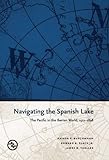Navigating the Spanish Lake : The Pacific in the Iberian World, 1521-1898 / Rainer F. Buschmann, James B. Tueller, Edward R. Slack; ed. by Anand A. Yang.
Material type: TextSeries: Perspectives on the Global PastPublisher: Honolulu : University of Hawaii Press, [2014]Copyright date: ©2014Description: 1 online resource (216 p.) : 4 b&w images, 1 map, 2 tablesContent type:
TextSeries: Perspectives on the Global PastPublisher: Honolulu : University of Hawaii Press, [2014]Copyright date: ©2014Description: 1 online resource (216 p.) : 4 b&w images, 1 map, 2 tablesContent type: - 9780824838249
- 9780824838256
- 325/.34609599 23
- DU65 .B87 2014
- online - DeGruyter
- Issued also in print.
| Item type | Current library | Call number | URL | Status | Notes | Barcode | |
|---|---|---|---|---|---|---|---|
 eBook
eBook
|
Biblioteca "Angelicum" Pont. Univ. S.Tommaso d'Aquino Nuvola online | online - DeGruyter (Browse shelf(Opens below)) | Online access | Not for loan (Accesso limitato) | Accesso per gli utenti autorizzati / Access for authorized users | (dgr)9780824838256 |
Frontmatter -- Contents -- Acknowledgments -- Foreword -- Introduction: Iberian Pacific Navigations -- 1. The Lake before the Nineteenth Century -- 2. Defending the Lake -- 3. Arming Chinese Mestizos in Manila -- 4. Colonizing the Marianas -- Epilogue: The Lingering Lake and Archipelagic Hispanization -- Notes -- Bibliography -- Index -- About the Authors
restricted access online access with authorization star
http://purl.org/coar/access_right/c_16ec
Navigating the Spanish Lake examines Spain's long presence in the Pacific Ocean (1521-1898) in the context of its global empire. Building on a growing body of literature on the Atlantic world and indigenous peoples in the Pacific, this pioneering book investigates the historiographical "Spanish Lake" as an artifact that unites the Pacific Rim (the Americas and Asia) and Basin (Oceania) with the Iberian Atlantic. Incorporating an impressive array of unpublished archival materials on Spain's two most important island possessions (Guam and the Philippines) and foreign policy in the South Sea, the book brings the Pacific into the prevailing Atlanticentric scholarship, challenging many standard interpretations. By examining Castile's cultural heritage in the Pacific through the lens of archipelagic Hispanization, the authors bring a new comparative methodology to an important field of research.The book opens with a macrohistorical perspective of the conceptual and literal Spanish Lake. The chapters that follow explore both the Iberian vision of the Pacific and indigenous counternarratives; chart the history of a Chinese mestizo regiment that emerged after Britain's occupation of Manila in 1762-1764; and examine how Chamorros responded to waves of newcomers making their way to Guam from Europe, the Americas, and Asia. An epilogue analyzes the decline of Spanish influence against a backdrop of European and American imperial ambitions and reflects on the legacies of archipelagic Hispanization into the twenty-first century.Specialists and students of Pacific studies, world history, the Spanish colonial era, maritime history, early modern Europe, and Asian studies will welcome Navigating the Spanish Lake as a persuasive reorientation of the Pacific in both Iberian and world history.
Issued also in print.
Mode of access: Internet via World Wide Web.
In English.
Description based on online resource; title from PDF title page (publisher's Web site, viewed 02. Mrz 2022)


